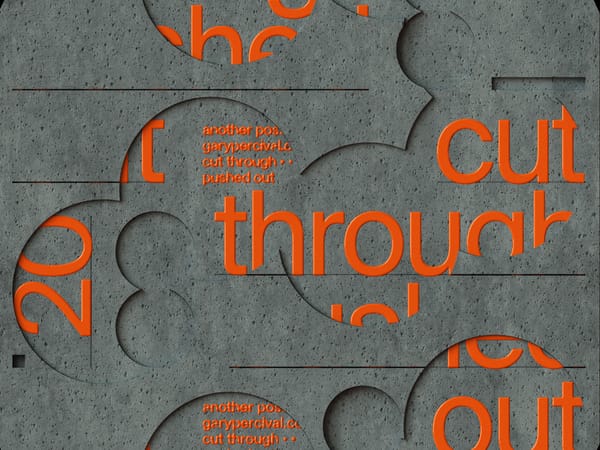Gravity Once Made No Sense. Neither Did Germs.
“Wrong is often the first draft of right.”
Every breakthrough looks obvious in hindsight.
Today, no one questions gravity. It’s how we stay grounded, why apples fall, why planets orbit. But for thousands of years, gravity made no sense. People believed the Earth was fixed, that objects moved to their “natural place,” or that the heavens spun by divine design.
The same was true of germs. Today, you wouldn’t step into surgery without doctors scrubbing up. But only 150 years ago, the idea that invisible organisms caused disease was laughed at. Doctors mocked the suggestion. Patients died because of it.
Every truth we now take for granted once sat on the other side of ridicule.
And here’s the uncomfortable part for us as creatives: the same is true of our work.
The Comfort of the Obvious
We’re trained to trust what feels obvious.
School rewards the simple answer: a math formula, a historical fact, a rule of grammar. You memorise, repeat, and get praised. The hidden message? If something doesn’t make immediate sense, avoid it.
But reality works differently. Progress begins in the awkward space of “that can’t be right.”
Gravity, germs, electricity, the internet—none of them looked obvious at first. They looked absurd.
Creativity Feels Wrong Before It Feels Right
Every creative knows this moment:
- A sketch that looks ridiculous.
- A colour palette that feels off.
- A tagline that reads awkwardly.
The instinct is to pull back, to choose something safer and more familiar. But here’s the thing: obvious ideas don’t move culture forward. They just repeat what’s already been done.
The work that matters usually starts out feeling like nonsense.
The Freelancer’s Dilemma
Freelancers feel this tension more than most.
Clients crave safety. They want “modern but timeless,” or “bold but clean,” or “fresh but familiar.” It’s tempting to give them exactly what they expect. Less risk, fewer questions.
But the work that builds reputations isn’t the safe work. It’s the piece that pushes just beyond the obvious—far enough to feel fresh, close enough to feel usable.
Your role isn’t just to design, write, or shoot. It’s to live in that tension, refining the strange until it becomes compelling.
History’s Reminder
Humanity has always been wrong before it was right.
- The Earth? Flat and stationary.
- Illness? Caused by “bad air” or moral weakness.
- Meteorites? Impossible. “Stones don’t fall from the sky.”
Newton, Semmelweis, and Pasteur—each insisted on ideas that sounded crazy at the time. Ridiculed first. Respected later.
The pattern is clear: breakthroughs always begin as heresies.
What This Means for Creatives
You’re not discovering laws of physics, but you are shaping how people see and feel. Every time you challenge convention—through a poster layout, a logo system, a new way of working—you’re stepping into that same uncomfortable zone.
It might feel wrong at first. Others might resist. But wrong is often the first draft of right.
The Danger of Familiarity
Scroll through Behance or Instagram and you’ll see it: repetition disguised as inspiration. The same grids, the same colours, the same treatments.
It all looks good. But does it move anything forward?
Safe ideas don’t stick. They blend in. They turn your work into design karaoke—polished but forgettable.
The Freelancer’s Advantage
Employees in big organisations often don’t have the room to explore. But freelancers do.
You can experiment publicly. Build side projects. Test ideas without waiting for approval. This is how new movements start—one individual sharing work that looks strange until it doesn’t.
The more you tolerate discomfort, the more distinct your voice becomes.
Putting It Into Practice
- Expect discomfort. Weird is a signal, not a stop sign.
- Prototype quickly. Make the strange visible so you can refine it.
- Share with the right people. Find peers who can critique without dismissing.
- Frame for clients. Position unusual as “how we stand out.”
- Balance the mix. Pair bold with safe to show contrast.
The point isn’t to reject the obvious—it’s to refuse to stop there.
The best ideas rarely feel obvious at the start. Discomfort is part of the process, not a warning sign.
Strange ideas become powerful when you refine them.
👉 If it feels wrong now, it might be right tomorrow.
Final Thought
Every building, product, or service you rely on began as an idea that looked ridiculous.
Gravity baffled. Germs were mocked. Electricity was dismissed as dangerous magic.
And yet persistence turned them into common sense.
As a freelancer, designer, or creative, you’re not just making things look good—you’re shaping what becomes normal. That means working past what feels obvious, into the awkward, the strange, the “wrong.”
Because what looks wrong today may be the thing the world can’t imagine living without tomorrow.
Thanks for reading. Until next time—trust what feels strange.
What strange idea in your notebook deserves another look this week?
—Gary



